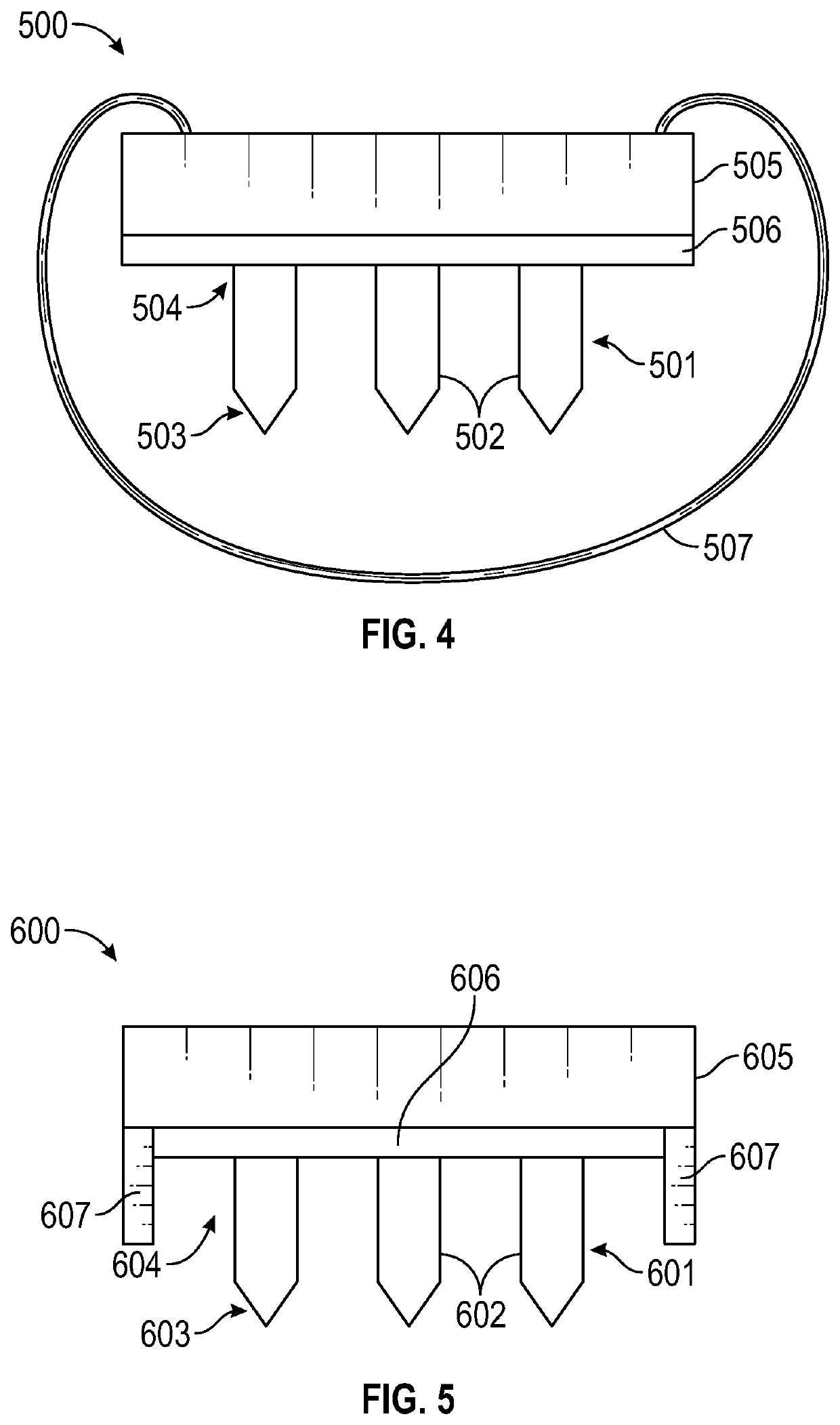Methods and Systems for Improved Collection of Interstitial Fluid
a technology of interstitial fluid and collection method, which is applied in the field of methods and systems for improving the collection of interstitial fluid, can solve the problems of limited blood monitoring, limited host biomarkers, and limited ability to assay biomarkers found in blood, etc., and achieves the effects of simple, reliable, and/or minimally invasiv
- Summary
- Abstract
- Description
- Claims
- Application Information
AI Technical Summary
Benefits of technology
Problems solved by technology
Method used
Image
Examples
example 1
le (MN) Patch Fabrication
[0122]In this example, MN patches were designed in SOLIDWORKS® 2016 software (SOLIDWORKS®, Waltham, Mass.) and fabricated from grade 316 stainless steel as five-needle planar arrays (Tech-Etch, Plymouth, Mass.) by photo etching. The MN length in this example varied from 250 μm to 650 μm, with a cross-sectional area of 200 μm by 25 μm at the base and a sharp tapered tip of 10 μm diameter.
[0123]The MN patches were disinfected by washing with sterile 70% isopropyl alcohol (VWR, Radnor, Pa.) in a class II BSL hood (Thermo Fisher Scientific, Waltham, Mass.), packaged into self-sealing sterilization pouches (Crosstex International, Englewood, Colo.) and sterilized using an ethylene oxide sterilization cycle (AN74i Anprolene Gas Sterilizer, Andersen Products, Haw River, N.C.) that was validated using a product immersion method (WuXi AppTec, Marietta, Ga.).
example 2
ing Using Microneedle Patches
[0124]In this example, the MN patches of Example 1 were used to collect relatively large quantities of ISF (i.e., ≥1 μL) with a minimally invasive method that was well-tolerated, rapid, and relatively simple. Moreover, the sample of this method used equipment that is commercially available at relatively low cost.
[0125]The ISF collection method of this example used MNs to create pathways for ISF flow from the skin using vacuum as a convective driving force. The vacuum application initiated a convective driving force that moved ISF through the dermis to the skin surface through MN-generated pathways. These micropores were created by pressing the patch of Example 1 into skin and then removing it. Vacuum was applied over the micropores to transport ISF through dermis and micropores to the skin surface.
[0126]FIG. 11A, FIG. 11B, FIG. 11C, and FIG. 11D are schematics depicting the method of this example. FIG. 11A depicts a sample of skin 100 that includes the s...
example 3
of Biomarkers
[0149]In this example, ISF, SBF and plasma were collected using the methods of Example 2 from 20 human participants, and more than 10,000 features were found by LC-MS analysis, more than two-thirds of which were common to ISF and plasma. This indicated that ISF may be a surrogate for plasma, at least in some cases. More features (14%) were determined to be unique to ISF by using a C18 column compared to 1% using HILIC. It was possible that the skin contained more lipophilic molecules that were captured more effectively by C18 compared to HILIC. Altogether, the data indicated that biomarkers in ISF derive mostly from plasma, there were also biomarkers specific to skin, many of which probably result from metabolic processes in the tissue.
[0150]Using a targeted approach to detect clinically valuable biomarkers, it was found that most biomarkers detected in plasma were also in ISF, further supporting the conclusion that ISF may be a substitute for blood for diagnostic tests...
PUM
 Login to view more
Login to view more Abstract
Description
Claims
Application Information
 Login to view more
Login to view more - R&D Engineer
- R&D Manager
- IP Professional
- Industry Leading Data Capabilities
- Powerful AI technology
- Patent DNA Extraction
Browse by: Latest US Patents, China's latest patents, Technical Efficacy Thesaurus, Application Domain, Technology Topic.
© 2024 PatSnap. All rights reserved.Legal|Privacy policy|Modern Slavery Act Transparency Statement|Sitemap



